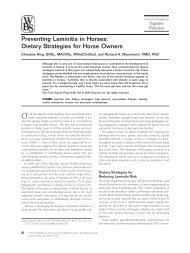Nutritional Secondary Hyperparathyroidism in the Horse
Nutritional Secondary Hyperparathyroidism in the Horse
Nutritional Secondary Hyperparathyroidism in the Horse
Create successful ePaper yourself
Turn your PDF publications into a flip-book with our unique Google optimized e-Paper software.
46 Experimental <strong>Nutritional</strong> <strong>Secondary</strong> <strong>Hyperparathyroidism</strong> <strong>in</strong> <strong>the</strong> <strong>Horse</strong> . . .<br />
less <strong>in</strong>cl<strong>in</strong>ed to play. IHe also showed a lack of freedom <strong>in</strong> mov<strong>in</strong>g his forelegs.<br />
At times his stride appearcd shortened and stilted. Percussion of his maxillary<br />
s<strong>in</strong>uses <strong>in</strong>dicated a slight loss of density.<br />
NSH 2 became progressively worse. Some days he would hesitate to move.<br />
He did not play spontaneously and if chased around <strong>the</strong> paddock preferred to<br />
canter ra<strong>the</strong>r than trot. After this forced exercise he would stand trembl<strong>in</strong>g on his<br />
forelegs. He was ly<strong>in</strong>g down more than <strong>the</strong> o<strong>the</strong>r colts. In attempt<strong>in</strong>g to rise he<br />
would extend his forelcgs and start to spr<strong>in</strong>g to his fcet <strong>in</strong> a normal manner but<br />
fail <strong>in</strong> <strong>the</strong> attcmpt and s<strong>in</strong>k back <strong>in</strong> sternal or fall <strong>in</strong> lateral recumbency. Two or<br />
three attempts were oftcn necessary before he rose to his feet.<br />
The mandibular cnlargcmcnt of NSH 2 progressed slightly, as did <strong>the</strong><br />
“cardboard” sound on percussion of <strong>the</strong> maxillary s<strong>in</strong>uses. By week 34 <strong>the</strong> facial<br />
crcst seemed to bc less prom<strong>in</strong>cnt, cspecially rostrally. Thc face began to have a<br />
full appearancc, lack<strong>in</strong>g sharp, bony angulations. The corner <strong>in</strong>cisor teeth could<br />
be moved slightly by hand.<br />
NSH 3 bcgan to have trouble ris<strong>in</strong>g dur<strong>in</strong>g week 25. tler movements with<br />
<strong>the</strong> forelegs became stiff and stilted. If forced to canter she moved with a peculiar<br />
“rabbit hopp<strong>in</strong>g” motion with her rear legs. The stiff, pa<strong>in</strong>ful, and very short<br />
stride secmed to account for <strong>the</strong> hopp<strong>in</strong>g appearance. The progress of this lameness<br />
was similar to that of NSH 2. Dur<strong>in</strong>g week 28 NSH 3 was lame <strong>in</strong> her right<br />
foreleg. She would not play spontaneously. Pcrcussion sound changes of <strong>the</strong><br />
frontal s<strong>in</strong>uses progrcsscd as <strong>in</strong> NSI-I 2. There was, however, no enlargement of <strong>the</strong><br />
mandible or maxilla.<br />
Dur<strong>in</strong>g week 35 throzgh week 41 NSH 1 rcma<strong>in</strong>ed <strong>the</strong> same. He was destroyed<br />
dur<strong>in</strong>g week 41. Early <strong>in</strong> week 40 NSH 2 was unable to rise. He had suffered a<br />
distal epiphyseal separation of <strong>the</strong> right radius. With <strong>the</strong> help of rope sl<strong>in</strong>gs he<br />
could be placed on his feet but would stand by himself for just a few m<strong>in</strong>utes.<br />
‘The area surround<strong>in</strong>g <strong>the</strong> distal radius was swollen and warm. The colt would<br />
not bear weight on his <strong>in</strong>jured foreleg. Subsequently, dccubital sores and rapid<br />
weight loss occurred. He was dcstroycd dur<strong>in</strong>g wcek 41. NSIH 3 showcd progrcs-<br />
sive difficulty <strong>in</strong> ris<strong>in</strong>g. IHer stride became shorter, stiffer, and more stilted, and<br />
she stumbled oftcn. Her toes wore down and her heels grew long. Percussion of thc<br />
maxillary s<strong>in</strong>uses <strong>in</strong>dicated a progressive decrcase <strong>in</strong> bone density. Swell<strong>in</strong>g was<br />
not evident <strong>in</strong> <strong>the</strong> mandible but was present to a mild degree <strong>in</strong> <strong>the</strong> maxilla. All<br />
her <strong>in</strong>cisor teeth could be moved by hand. She was destroyed dur<strong>in</strong>g weck 41.<br />
The control horse was vigorous and playful. His hoofs wore more evenly<br />
than those of NSIH 2 or NSH 3. No symptoms of lameness were noted. In general,<br />
his facial contours were much sharpcr than those of NSH 2 or NSH 3. He was<br />
destroyed dur<strong>in</strong>g week 42.<br />
2. Cl<strong>in</strong>ico-pathologic Determ<strong>in</strong>ations<br />
The results of weekly determ<strong>in</strong>ations of phosphorus, calcium, and<br />
alkal<strong>in</strong>e phosphatase levels of blood serum are presented <strong>in</strong> Charts 5<br />
through 8 (regression equations are given <strong>in</strong> <strong>the</strong> Appendix, Table 111).<br />
The results may be summarized as follows:<br />
Downloaded from<br />
vet.sagepub.com by guest on April 14, 2010



